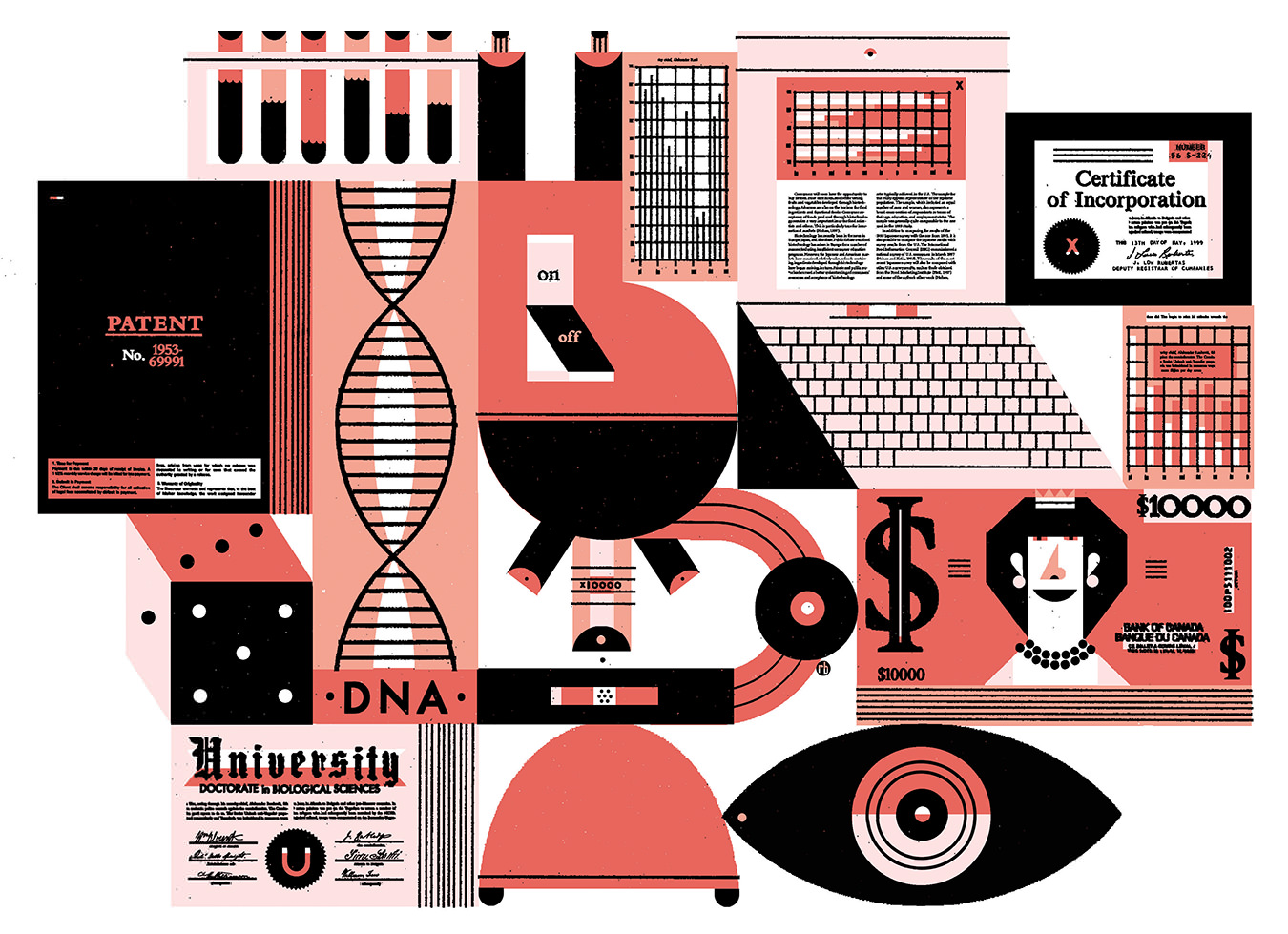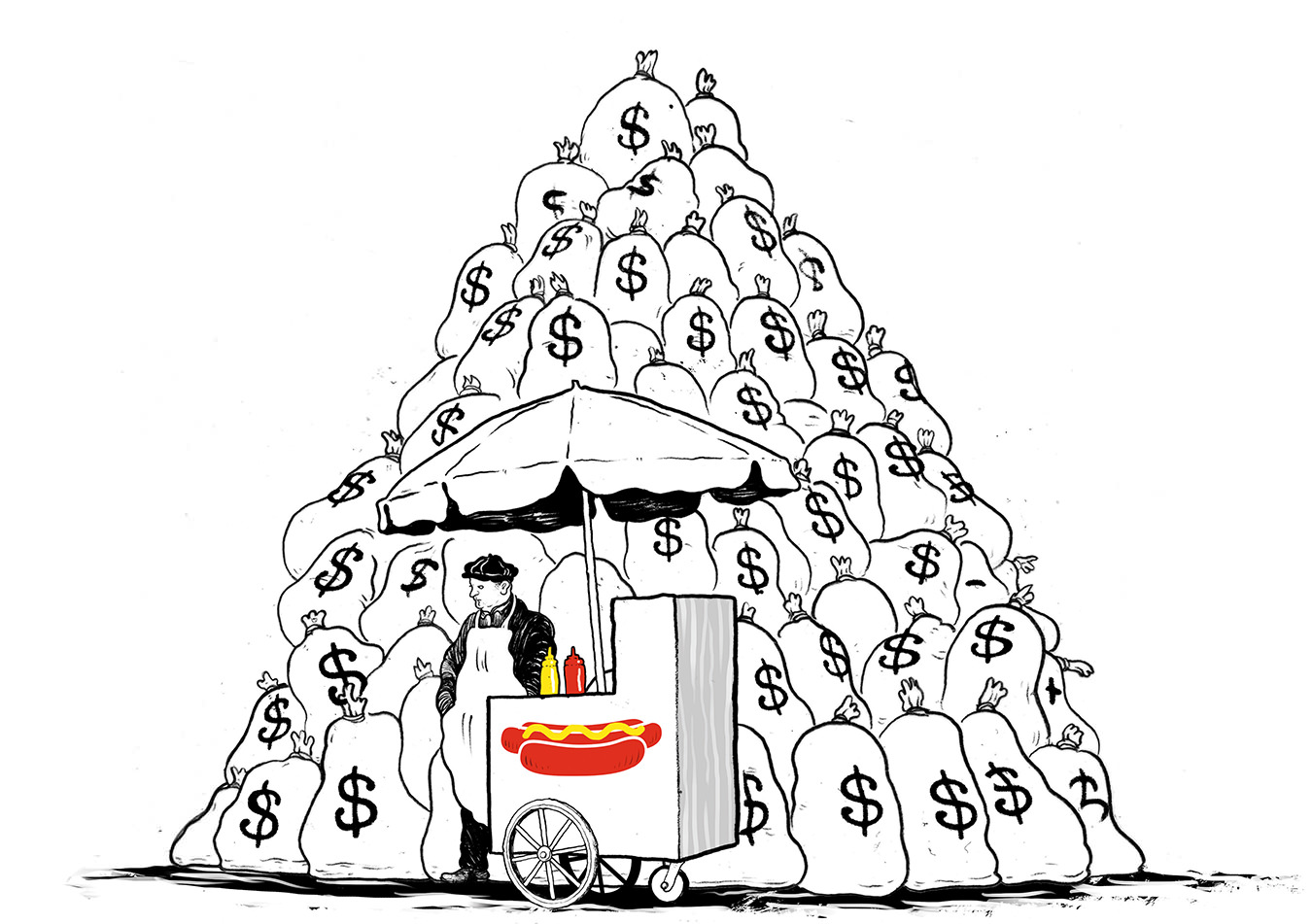Investing in Biotechnology
Just what the doctor ordered.

Illustration by Raymond Biesinger.
Hard drives, silicon wafers, evil robots bent on destroying humanity—just a few of the things that come to mind when one’s thoughts turn to technology. But there is another side to technology, one that has nothing to do with either Silicon Valley or galaxies far, far away. A technology expressed not in ones and zeros, but in the complex sequences of proteins and amino acids that form the building blocks of life itself.
Like much of advanced science, the exact definition of biotechnology is open to debate. In the broadest possible terms, the word describes the use or manipulation of biological organisms—a cell, a tissue sample, an entire animal—to improve our world. The use of yeast for brewing beer would be a familiar, if crude, example.
These days, biotechnology takes place in the laboratory, and its practitioners are more likely to reach for the electron microscope than they are a bushel of hops. With the rapid advancement of genetic engineering and its attendant technologies, it is now possible to manipulate the cellular makeup of viruses, bacteria, and proteins in order to create completely new drugs or health-care therapies—including treatments individually formulated for a patient’s unique DNA. It is at this intersection of microbiology and nanoengineering where some of the greatest science of the day is taking place.
And, it should be noted, some of its greatest investing. Finding new drugs for rare, previously untreatable diseases is, as you might expect, a rather profitable business. Although it’s not a sure thing—a 2011 study from the Biotechnology Industry Organization pegged the odds that a given biotech drug will be approved by United States regulators at about 15 per cent—those companies that do make it are the investment equivalent of striking oil, winning the lottery, and finding a cache of pirate treasure buried under the compost heap in the backyard all at the same time.
As a sector, biotechnology has been one of the strongest performers since the great market rout of 2007. Going back to September 2008, the Nasdaq Biotechnology Index (a proxy for the sector as a whole) has generated a cumulative return of 20.04 per cent, or about 6.68 per cent a year. In and of itself, that’s not a particularly impressive number, but compare it to the performance of the granddaddy of all stock market indices, the Dow Jones Industrials, which has posted a meagre 3.13 per cent over the same three-year period, or about 1.04 per cent a year.
Not to say that the ride is always smooth. In fact, putting your hard-earned cash into a biotech company is akin to a game of Russian roulette: the stakes are high, and there can be only one of two outcomes. A biotech company either obtains FDA approval for its drug, or it doesn’t. It either burns through its stockpile of cash, or it doesn’t. It either finds a patentable molecule or the past three, five, 10 years (or longer) has been a colossal waste of time.
Given the binary nature of biotech outcomes, why bother? Because the payoff can be big. Very big. Case in point: Alexion Pharmaceuticals, a company specializing in biologically derived drug treatments for ultrarare blood disorders. Those wise (or lucky) enough to have put $100,000 into the company back in January 2006 would have almost $1.4-million in their pockets as of October 2011, for an annualized return of more than 69 per cent. With numbers like this, it’s little wonder why some investors believe biotech is the perfect prescription for portfolio growth.
Where The Action Is
One analyst who has demonstrated a knack for backing the right guys in the right lab is Lauren Migliore. An equity analyst at Chicago-based Morningstar, Migliore’s specialty is biotech—specifically, the small, up-and-coming, little-known firms that are on the bleeding edge of both science and risk. Such is Migliore’s talent that she was named by The Wall Street Journal as one of the top stock pickers in the sector in the paper’s 19th annual Best on the Street rankings in May 2011.
As Migliore explains, these are heady days for the biotechnology industry. “There’s a great deal of innovation and exciting things going on in the sector,” she says. As many blockbuster drugs come off patent, traditional pharmaceutical companies have gone hunting for the next money-maker, attempting to buy what their internal R&D teams haven’t been able do for themselves.
Migliore points out that one of the ways big pharmaceutical companies can revitalize a drug portfolio is to add a little biotech to the product mix. Instead of developing biologics from the ground up, it’s often easier to swallow a biotech start-up whole. “We’re seeing biotech increasingly become the innovative arm of big pharma,” Migliore explains. “Whether it’s through M&A or collaboration, as R&D productivity at big pharma slows down, they’re increasingly turning to biotech as really the lab bench for new and innovative therapies.”
And that means good times for shareholders. For biotech investors, a merger or acquisition by a cash-rich pharma company is a financial dream come true. To name just one well-known example, investors in Boston-based Genzyme Corporation were rewarded handsomely when French pharmaceutical giant Sanofi-Aventis bought the company for $20.1-billion (all currency in U.S. dollars), or $74 per share in cash. The price represented a 24-hour return of 48 per cent to the closing share price when the deal was announced. Not a bad day’s work.
Why does big pharma care so much about biologic drugs? It’s simple, really: because they’re tough to make. After a drug loses its 20-year U.S. patent protection, generic companies are free to replicate it, and such competition obviously cuts into profits. As Migliore points out, this kind of commercial copycatting is considerably more difficult with a drug derived from life itself rather than some concoction of chemicals. “It’s increased protection compared to small molecule drugs, the fact that you’re dealing with living, large molecules,” she says. Although this isn’t a hard and fast rule—older biologic drugs utilize older technology, and are thus much easier to replicate—it does provide most biotech firms with at least some means to beat back generic competition. “We do see a spectrum [of protection] in the space,” says Migliore.
For investors, biotech offers protection of another kind. While the performance of world stock markets has become increasingly connected, biotechnology stocks insist on marching to the beat of their own drum. “[Biotech] investing gives you exposure to returns that are often uncorrelated to the market,” Migliore explains. “They’re correlated more with drug data and approval data.” In practical terms, that means the share price of the average biotech has more to do with patient trials, efficacy data, and what’s going on at the FDA than it does with Chinese demand for copper, the progress of the latest European bailout, or any number of other macro- or microeconomic issues that cause the broader market to soar or sink. That’s something that has been hard to come by lately.
Swinging For The Fences
Given the inherent risks evident in biotech investing, Migliore suggests the best way to break into the sector is probably with one of the biotech Exchange-Traded Funds (ETFs) that currently trade on American exchanges. Particularly for investors of more modest means, a biotech ETF can be an excellent way to spread risk among different names. “I think it’s a good strategy,” Migliore says, “especially because you do need such a large margin of safety to invest.”
For veterans willing to place their bets and take their chances, Migliore suggests sticking with companies that exhibit the easy-to-recognize signs of long-term survival. “We like to see companies with lengthy patent portfolios and full pipelines to spread development risk out,” she says. “It’s important for firms to have lots of cash, because it allows them to hang on to the full rights of their products and perform really well-controlled clinical trials used for regulatory approvals.”
As for companies that don’t meet such rigorous evaluation, Migliore is diplomatic yet unyielding in her assessment. “Investors should approach biotechs with no revenue, no partners, waning cash, a volatile stock price, and a weak pipeline of drugs that probably won’t be approved for years, if at all, with an extreme amount of caution.”
Migliore has a couple of names that have earned her stamp of approval. Among established biotech firms, she’s a fan of Roche, the large Swiss-based pharmaceutical firm that made a big entry into biotechnology by snapping up stock-market darling Genentech for the cool price of $46.8-billion. Although pricing pressure and setbacks with the firm’s leading cancer drug have cast a pall on the stock price of late, there’s still plenty to like. “Roche’s long patent life lessens the drug portfolio’s exposure to generic competition,” Migliore says. “[While] Roche’s focus on branded biologics and diagnostics really positions the firm well to thrive if personalized medicine takes off.”
For investors with deeper wallets and stronger stomachs, Migliore suggests taking a closer look at Vanda Pharmaceuticals. She notes that Vanda is a rather atypical example of a biotechnology company: it bought the rights to its antipsychotic biologic Fanapt from big pharma, rather than the other way around. “[It] represents an attractive risk/reward trade-off,” Migliore says. “We think Vanda’s existing valuation implies very minimal Fanapt sales, which helps limit potential downside for investors while upside remains significant.” The fact that the company is trading below cash levels provides further protection: investors are essentially buying the business for free. In times like these, that sounds like just what the doctor—or the microbiologist, or the genetic engineer, or all three—ordered.




